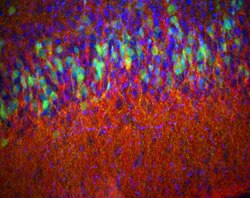Theparalimbic cortexis an area of three-layeredcortexthat includes the following regions: thepiriform cortex,entorhinal cortex,theparahippocampal cortexon themedialsurface of thetemporal lobe,and thecingulate cortexjust above thecorpus callosum.[1][2]
| Paralimbic cortex | |
|---|---|
 Piriform cortex from a 14-day-old mouse, stained for D2-eGFP (green), enkephalin (red) andDAPI(blue) to show nuclei.Epifluorescence. | |
| Details | |
| Identifiers | |
| Latin | Cortex paralimbicus |
| Anatomical terms of neuroanatomy | |
The paralimbic cortex lies close to, and is directly connected with, the structures of thelimbic system.[1](The prefixparameaning beside or adjacent to.) The paralimbic cortex, also referred to as themesocortex,or juxtallocortex, is interposed between theneocortexand theallocortex.[3]The paralimbic cortex provides a gradual transition from primary limbic regions, including theseptal region,substantia innominata,and theamygdalanuclei, to higher neocortical regions.[4]
There are dense connections between the paralimbic cortex and core limbic structures, in particular the amygdala. The amygdaloid complex comprises both nuclear and cortical layers. These cortical features of the amygdala often extend into the paralimbic areas, blurring the boundaries between limbic and paralimbic regions.[5]Thus, these regions may collectively be termed the ‘paralimbic system’.
It iscytoarchitecturallydefined: it has three layers, where layers 2, 3 and 4 are merged, and is intermediate in form between theallocortex(less than six layers) and the neocortex (six distinct layers). It is found within thelimbic system,representing the border between neocortical and allocortical parts.[6][7]It has been hypothesized that the cortex should be viewed as concentric rings of allocortex, mesocortex (paralimbic cortex), and isocortex (neocortex).[8]
Functions
editThis sectionneeds expansion.You can help byadding to it.(December 2012) |
The paralimbic cortex serves as a transitional region between the neocortex and the allocortex incorporating a region ofproisocortex,as a subdivision of the neocortex, and a region ofperiallocortex,as a subdivision of the allocortex.[9]
It constitutes a group of interconnecting brain structures that are involved in the functions ofemotion processing,goal setting,motivationandself-control.
- The paralimbic cortex integrates external sensory information with internal emotional and motivational states, serving as an interface between higher-order cognition and basic emotional/behavioral processes.[10]
- The olfactocentric paralimbic cortex critically regulates emotional and autonomic functions, overseeing the regulation of emotional and neurovegetative functions.
- Specific paralimbic regions like Brodmann area 10 are activated during more complex working memory and cognitive tasks, indicating their involvement in episodic and working memory tasks, as well as abstract cognitive function.[11]
- The perirhinal cortex, a paralimbic region, integrates item information with spatial/temporal data and transmits this to the hippocampus, contributing significantly to declarative memory processing and item identification.[12]
- The orbitofrontal cortex, a paralimbic area, plays a key role in the evaluation of rewards and punishment, as well as in self-regulation and behavioral inhibition.
See also
editReferences
edit- ^abKolb & Whishaw:Fundamentals of Human Neuropsychology,2003.
- ^Mesulam, 2000 In: M.M. Mesulam, Editor, Principles of Behavioral and Cognitive Neurology (2nd ed.), Oxford University Press, New York (2000)
- ^mediLexicon: Definition: 'Juxtallocortex'.http://www.medilexicon.com/medicaldictionary.php?t=46602
- ^Mesulam, 2000 In: M.M. Mesulam, Editor, Principles of Behavioral and Cognitive Neurology (2nd ed.), Oxford University Press, New York (2000)
- ^Mesulam, 2000 In: M.M. Mesulam, Editor, Principles of Behavioral and Cognitive Neurology (2nd ed.), Oxford University Press, New York (2000)
- ^G. Avanzini,Anne Beaumanoir,Laura Mira, eds. Limbic Seizures in Children. John Libbey Eurotext, 2001, p. 13
- ^Almut Schuez, Robert Miller. Cortical Areas: Unity and Diversity. CRC Press, 13 Jul 2003, pp. 236-237.
- ^Reep R. Relationship between prefrontal and limbic cortex: a comparative anatomical review. Brain Behav Evol. 1984;25(1):5-80.
- ^"BrainInfo".Retrieved17 June2014.
- ^Clinical Neuroscience.
- ^"Limbic/Paralimbic System - Connectome Guide".www.o8t.com.Retrieved2024-04-17.
- ^"Limbic/Paralimbic System - Connectome Guide".www.o8t.com.Retrieved2024-04-17.